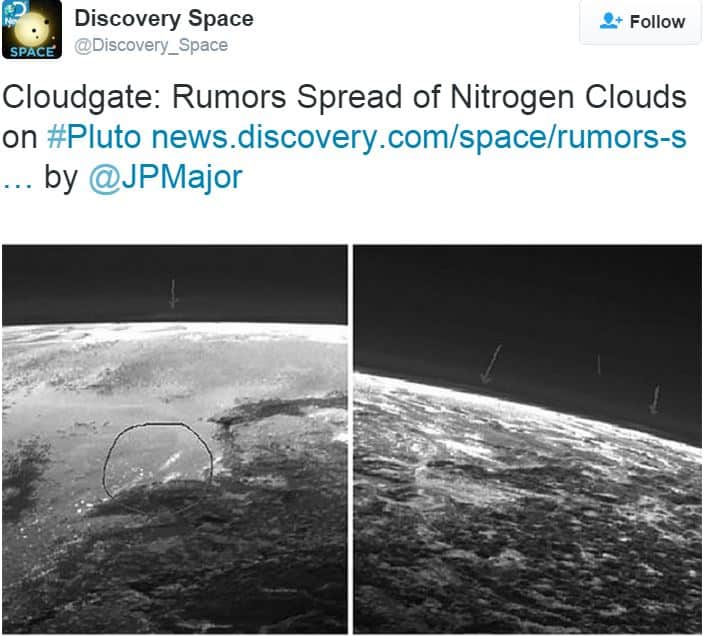Clouds have been detected on Pluto, which scientists argue should be reason enough to promote it back to planet status, which it lost ten years ago – many astronomers disagreed with the decision. NASA’s New Horizons space probe, which flew past Pluto in July 2015 and took lots of pictures, may have discovered clouds floating above its surface. How can finding clouds make any difference to Pluto’s status (see end of article)?
According to an exclusive New Scientist report, images released publicly by New Horizons scientists have already revealed the dwarf planet’s remarkably complex atmosphere, which contains several layers of haze rising above frozen mountains.
However, New Scientist reporter Jacob Aron says his publication has seen emails and images where New Horizons scientists talk about the possibility of individual clouds hovering above Pluto’s surface, suggesting its atmosphere is even richer and more diverse than we realise.
 Can you see the clouds on Pluto? Presumable, they are the smaller white things floating above the dwarf planet’s surface, while the haze covers much wider areas. (Image: NASA/JHUAPL/SwRI)
Can you see the clouds on Pluto? Presumable, they are the smaller white things floating above the dwarf planet’s surface, while the haze covers much wider areas. (Image: NASA/JHUAPL/SwRI)
Emails discussing possible clouds on Pluto
A few days after images of the haze pictures were released to the public, Will Grundy, who works at the Lowell Observatory in Arizona, sent an email on 13th September to a discussion list dedicated to analyzing Pluto’s atmosphere.
Dr. Grundy wrote:
“There are a few fairly localized low-altitude features just above the limb that I’ve drawn lame arrows pointing to, but also a few bright cloud-like things that seem to be above and cutting across the topography in the circled area.”
Dr. Grundy had identified cloud-like features in the haze on the edge of Pluto that stood out from the distinct layers. He had also spotted a bright feature crossing various parts of the landscape, suggesting it was floating above.
His email got everybody talking about whether there might be clouds on Pluto. Some wrote saying it was not possible to determine whether they cast clouds on the planet’s surface.
 There is also a lot of talk in social media sites about clouds on Pluto. (Image: twitter.com/Discovery_Space)
There is also a lot of talk in social media sites about clouds on Pluto. (Image: twitter.com/Discovery_Space)
Haze and clouds are different
Alan Stern, head of the New Horizon’s mission, wrote regarding the difference between haze and clouds:
“One way to think of it is that clouds are discrete features, hazes widespread.”
Since nobody in the group has talked publicly about the possibility of clouds, it is likely that none of them really knows what was detected.
The New Scientist also saw emails written by the team which discussed a paper soon to be published in the academic journal Science – ‘The Atmosphere of Pluto as Observed by New Horizons’ – which does mention clouds, but only as a passing comment referring to an unsolved mystery.
John Spencer, Institute Scientist at Department of Space Studies, Southwest Research Institute in Boulder, Colorado, sent an email on 1st March with pictures, and wrote:
“In the first image an extremely bright low altitude limb haze above south-east Sputnik on the left, and a discrete fuzzy cloud seen against the sunlit surface above Krun Macula (I think) on the right.”
Nobody talks about what the clouds could be made of. The New Scientist believes they are probably similar in composition to the planet’s general atmosphere – nitrogen, plus traces of ethane, ethylene, acetylene and methane.
What is the definition of a planet?
According to NASA, Astronomers of the International Astronomical Union (IAU) voted on and passed the first scientific definition of a planet in August 2006. They said a planet:
– Must orbit the Sun.
– Must be big enough for gravity to squash it into a round ball.
– Must have cleared the other objects out of its way in its orbital neighbourhood, i.e. it must be big enough to pull in all objects nearby into itself, or sling-shot them around itself and shoot them off into outer space.
According to the IAU, pluto falls short on the third requirement, and is now in a new class of celestial objects called ‘dwarf planets’.
Surely, finding clouds on Pluto shouldn’t make any difference to its status, should it?
Video – Did New Horizons detect clouds on Pluto?
